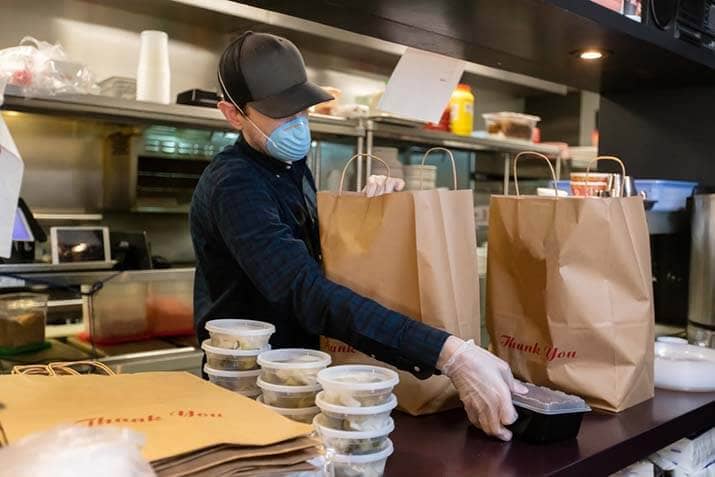Delivery
Is the ghost model right for you?
Sep 28, 2020

Ghost kitchens, cloud kitchens, virtual kitchens—all are different names for similar concepts. A ghost kitchen is a kitchen that is purely for takeout or delivery—no front-of-house, no guests, just a place for delivery drivers to pick up orders.
The pros and cons of the ghost model
Deciding whether or not to go with a ghost kitchen is complicated and specific to your business. Let’s take a look at some of the pros and cons.
Pros
Low Overhead Cost
One of the biggest benefits to using a ghost kitchen is reduced costs like rent and labor costs. Sometimes if you’re a part of a ghost kitchen, you can also work with other tenants to negotiate other contracts together, like restaurateur Aaron Gordon who moved into the Washington D.C. ghost food hall Ghostline.
“Multiple chefs contribute to the costs of rent, packaging and delivery, making the enterprise much less expensive than it would be for any chef striking out on their own. Already, Gordon said having the leverage of multiple chefs allowed them to drive down their credit-card processing fee from 3 percent to 2.5 percent.”1
Quick Start-up
You don’t have to worry about construction and building out a new space. For most ghost kitchens, you just hire your team, take care of the marketing, and start cooking.
Flexibility & Experimentation
With the ghost kitchen model, your presence is purely online and your menu is much more easily adaptable. If an ingredient cost goes up and makes a dish cost prohibitive, take it off the menu. Online platforms give you a lot of ordering data, so you can test what dishes are the most popular and get rid of the ones that aren’t.
A lot of restaurant companies are using the ghost kitchen model to increase their reach by operating several restaurants or brands out of one kitchen. One of these is Salted, a restaurant group based out of Los Angeles that doesn’t have any physical locations. They operate out of ghost kitchens, and each locations has all six brands running at once.2
Most third-party delivery apps only have a three- to five-mile delivery radius, which limits who you can reach. If your location is in a downtown center or away from residential parts of town, that might mean you can’t reach a lot of potential customers. Ghost kitchens are usually set in parts of town that can reach those residential neighborhoods, so you can extend your delivery reach.
Cons
Customer Loyalty
This might be the biggest downside to ghost kitchens. The question of who owns the customer relationship can make things more complicated for you as a business owner. “The apps are so popular at this point that the customers won't always come back,” says David Yaffe-Bellany, business reporter for Bloomberg News. “So if a restaurant that’s listed on Grubhub were to leave Grubhub, then it would ultimately be in a worse situation. Restaurants are stuck between a rock and a hard place.” Customers are going directly to restaurant websites or apps, but 53% of consumers say they used a third-party delivery at least once a month.3
Digital Marketing Acumen Required
Your digital marketing game has to be really strong in order to compete online. Most likely whatever you save from lower overhead and labor costs will go towards various marketing and advertising campaigns. If your restaurant or group already has a strong brand presence in your area, then this may not be as much of an issue.
The vast majority of the third-party delivery apps aren’t making a profit today and, if they are, it’s very slim. So it’s unclear what that means for the future and what kinds of policies they will put in place to make more money. “Seems unlikely that it will just collapse— the demand for delivery is so great it seems unlikely,” says Yaffe-Bellany. “But it’s unclear what kind of consolidation and/or changes to the business models will happen. And if you're a businessperson stuck in the middle of that, it creates a lot of anxiety.”
Ghost Kitchens and Ghost Kitchen Companies
There are several companies that are opening various forms of ghost kitchens, whether they’re commissary kitchens or shared kitchen spaces. Here are a few ghost kitchens to keep an eye on:
If you want to avoid larger companies in the ghost kitchen space, check into commissary kitchens and restaurants that are renting space as ghost kitchens like Forage Kitchen in Oakland, CA, or Ghostline in Washington, D.C. Smaller, more community-minded kitchens may be more willing to negotiate on terms and be able to help market to local customers.
Ultimately, whether or not you decide to expand your business into a ghost kitchen space will depend on how you weigh the pros and cons. It’s important for you to do your research and gather data from your current operations. If that research reveals that expanding into a new location will help boost your sales and outweigh the potential costs, great. Just be sure to put some extra effort into your digital marketing efforts to continue to engage your customers.
- https://www.washingtonpost.com/food/2020/07/18/pandemic-has-hit-restaurants-hard-experts-say-ghost-food-hall-concept-might-save-them/
- https://www.hellosalted.com/
- National Restaurant Association and Technomic Inc., Harnessing Technology to Drive Off-Premises Sales, 2019


